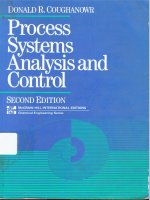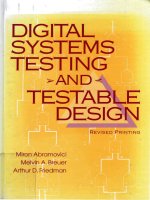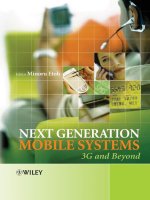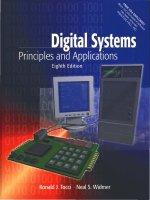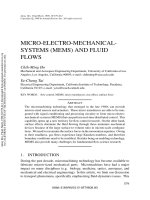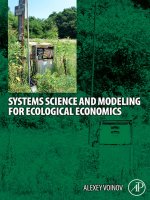Systems controls embedded systems energy and machines
Bạn đang xem bản rút gọn của tài liệu. Xem và tải ngay bản đầy đủ của tài liệu tại đây (17.62 MB, 672 trang )
The Electrical Engineering Handbook
Third Edition
Systems, Controls,
Embedded Systems,
Energy, and Machines
The Electrical Engineering Handbook Series
Series Editor
Richard C. Dorf
University of California, Davis
Titles Included in the Series
The Handbook of Ad Hoc Wireless Networks, Mohammad Ilyas
The Avionics Handbook, Cary R. Spitzer
The Biomedical Engineering Handbook, Third Edition, Joseph D. Bronzino
The Circuits and Filters Handbook, Second Edition, Wai-Kai Chen
The Communications Handbook, Second Edition, Jerry Gibson
The Computer Engineering Handbook, Vojin G. Oklobdzija
The Control Handbook, William S. Levine
The CRC Handbook of Engineering Tables, Richard C. Dorf
The Digital Signal Processing Handbook, Vijay K. Madisetti and Douglas Williams
The Electrical Engineering Handbook, Third Edition, Richard C. Dorf
The Electric Power Engineering Handbook, Leo L. Grigsby
The Electronics Handbook, Second Edition, Jerry C. Whitaker
The Engineering Handbook, Third Edition, Richard C. Dorf
The Handbook of Formulas and Tables for Signal Processing, Alexander D. Poularikas
The Handbook of Nanoscience, Engineering, and Technology, William A. Goddard, III,
Donald W. Brenner, Sergey E. Lyshevski, and Gerald J. Iafrate
The Handbook of Optical Communication Networks, Mohammad Ilyas and
Hussein T. Mouftah
The Industrial Electronics Handbook, J. David Irwin
The Measurement, Instrumentation, and Sensors Handbook, John G. Webster
The Mechanical Systems Design Handbook, Osita D.I. Nwokah and Yidirim Hurmuzlu
The Mechatronics Handbook, Robert H. Bishop
The Mobile Communications Handbook, Second Edition, Jerry D. Gibson
The Ocean Engineering Handbook, Ferial El-Hawary
The RF and Microwave Handbook, Mike Golio
The Technology Management Handbook, Richard C. Dorf
The Transforms and Applications Handbook, Second Edition, Alexander D. Poularikas
The VLSI Handbook, Wai-Kai Chen
The Electrical Engineering Handbook
Third Edition
Edited by
Richard C. Dorf
Circuits, Signals, and Speech and Image Processing
Electronics, Power Electronics, Optoelectronics,
Microwaves, Electromagnetics, and Radar
Sensors, Nanoscience, Biomedical Engineering,
and Instruments
Broadcasting and Optical Communication Technology
Computers, Software Engineering, and Digital Devices
Systems, Controls, Embedded Systems, Energy,
and Machines
The Electrical Engineering Handbook
Third Edition
Systems, Controls,
Embedded Systems,
Energy, and Machines
Edited by
Richard C. Dorf
University of California
Davis, California, U.S.A.
Boca Raton London New York
A CRC title, part of the Taylor & Francis imprint, a member of the
Taylor & Francis Group, the academic division of T&F Informa plc.
Published in 2006 by
CRC Press
Taylor & Francis Group
6000 Broken Sound Parkway NW, Suite 300
Boca Raton, FL 33487-2742
© 2006 by Taylor & Francis Group, LLC
CRC Press is an imprint of Taylor & Francis Group
No claim to original U.S. Government works
Printed in the United States of America on acid-free paper
10 9 8 7 6 5 4 3 2 1
International Standard Book Number-10: 0-8493-7347-6 (Hardcover)
International Standard Book Number-13: 978-0-8493-7347-3 (Hardcover)
Library of Congress Card Number 2005054347
This book contains information obtained from authentic and highly regarded sources. Reprinted material is quoted with
permission, and sources are indicated. A wide variety of references are listed. Reasonable efforts have been made to publish
reliable data and information, but the author and the publisher cannot assume responsibility for the validity of all materials
or for the consequences of their use.
No part of this book may be reprinted, reproduced, transmitted, or utilized in any form by any electronic, mechanical, or
other means, now known or hereafter invented, including photocopying, microfilming, and recording, or in any information
storage or retrieval system, without written permission from the publishers.
For permission to photocopy or use material electronically from this work, please access www.copyright.com
( or contact the Copyright Clearance Center, Inc. (CCC) 222 Rosewood Drive, Danvers, MA
01923, 978-750-8400. CCC is a not-for-profit organization that provides licenses and registration for a variety of users. For
organizations that have been granted a photocopy license by the CCC, a separate system of payment has been arranged.
Trademark Notice: Product or corporate names may be trademarks or registered trademarks, and are used only for
identification and explanation without intent to infringe.
Library of Congress Cataloging-in-Publication Data
Systems, controls, embedded systems, energy, and machines / edited by Richard C. Dorf.
p. cm.
Includes bibliographical references and index.
ISBN 0-8493-7347-6 (alk. paper)
1. Electric power systems--Control. 2. Electric power systems. 3. Systems engineering. I. Dorf, Richard
C. II. Title.
TK1001.S93 2005
621.3--dc22
2005054347
Visit the Taylor & Francis Web site at
Taylor & Francis Group
is the Academic Division of Informa plc.
and the CRC Press Web site at
Preface
Purpose
The purpose of The Electrical Engineering Handbook, 3rd Edition is to provide a ready reference for the
practicing engineer in industry, government, and academia, as well as aid students of engineering. The third
edition has a new look and comprises six volumes including:
Circuits, Signals, and Speech and Image Processing
Electronics, Power Electronics, Optoelectronics, Microwaves, Electromagnetics, and Radar
Sensors, Nanoscience, Biomedical Engineering, and Instruments
Broadcasting and Optical Communication Technology
Computers, Software Engineering, and Digital Devices
Systems, Controls, Embedded Systems, Energy, and Machines
Each volume is edited by Richard C. Dorf and is a comprehensive format that encompasses the many
aspects of electrical engineering with articles from internationally recognized contributors. The goal is to
provide the most up-to-date information in the classical fields of circuits, signal processing, electronics,
electromagnetic fields, energy devices, systems, and electrical effects and devices, while covering the emerging
fields of communications, nanotechnology, biometrics, digital devices, computer engineering, systems, and
biomedical engineering. In addition, a complete compendium of information regarding physical, chemical,
and materials data, as well as widely inclusive information on mathematics, is included in each volume. Many
articles from this volume and the other five volumes have been completely revised or updated to fit the needs
of today, and many new chapters have been added.
The purpose of Systems, Controls, Embedded Systems, Energy, and Machines is to provide a ready reference to
subjects in the fields of energy devices, machines, and systems, as well as control systems and embedded
systems. Here we provide the basic information for understanding these fields. We also provide information
about the emerging fields of embedded systems.
Organization
The information is organized into three sections. The first two sections encompass 20 chapters, and the last
section summarizes the applicable mathematics, symbols, and physical constants.
Most chapters include three important and useful categories: defining terms, references, and further
information. Defining terms are key definitions and the first occurrence of each term defined is indicated in
boldface in the text. The definitions of these terms are summarized as a list at the end most chapters or articles.
The references provide a list of useful books and articles for follow-up reading. Finally, further information
provides some general and useful sources of additional information on the topic.
Locating Your Topic
Numerous avenues of access to information are provided. A complete table of contents is presented at the
front of the book. In addition, an individual table of contents precedes each of the sections. Finally, each
chapter begins with its own table of contents. The reader should look over these tables of contents to become
familiar with the structure, organization and content of the book. For example, see Section I: Energy, then
Chapter 2: Alternative Power Systems and Devices, and then Chapter 2.1: Distributed Power. This tree-andbranch table of contents enables the reader to move up the tree to locate information on the topic of interest.
Two indexes have been compiled to provide multiple means of accessing information: a subject index and
an index of contributing authors. The subject index can also be used to locate key definitions. The page on
which the definition appears for each key (defining) term is clearly identified in the subject index.
The Electrical Engineering Handbook, 3rd Edition is designed to provide answers to most inquiries and direct
the inquirer to further sources and references. We hope that this volume will be referred to often and that
informational requirements will be satisfied effectively.
Acknowledgments
This volume is testimony to the dedication of the Board of Advisors, the publishers, and my editorial
associates. I particularly wish to acknowledge at Taylor and Francis Nora Konopka, Publisher; Helena
Redshaw, Editorial Project Development Manager; and Mimi Williams, Project Editor. Finally, I am indebted
to the support of Elizabeth Spangenberger, Editorial Assistant.
Richard C. Dorf
Editor-in-Chief
Editor-in-Chief
Richard C. Dorf, Professor of Electrical and Computer Engineering at the University of California, Davis,
teaches graduate and undergraduate courses in electrical engineering in the fields of circuits and control
systems. He earned a Ph.D. in electrical engineering from the U.S. Naval Postgraduate School, an M.S. from
the University of Colorado, and a B.S. from Clarkson University. Highly concerned with the discipline of
electrical engineering and its wide value to social and economic needs, he has written and lectured
internationally on the contributions and advances in electrical engineering.
Professor Dorf has extensive experience with education and industry and is professionally active in the fields
of robotics, automation, electric circuits, and communications. He has served as a visiting professor at the
University of Edinburgh, Scotland; the Massachusetts Institute of Technology; Stanford University; and the
University of California, Berkeley.
Professor Dorf is a Fellow of The Institute of Electrical and Electronics Engineers and a Fellow of the
American Society for Engineering Education. Dr. Dorf is widely known to the profession for his Modern
Control Systems, 10th Edition (Addison-Wesley, 2004) and The International Encyclopedia of Robotics (Wiley,
1988). Dr. Dorf is also the co-author of Circuits, Devices and Systems (with Ralph Smith), 5th Edition (Wiley,
1992), and Electric Circuits, 7th Edition (Wiley, 2006). He is also the author of Technology Ventures (McGrawHill, 2005) and The Engineering Handbook, 2nd Edition (CRC Press, 2005).
Advisory Board
Frank Barnes
University of Colorado
Boulder, Colorado
William Kersting
New Mexico State University
Las Cruces, New Mexico
Joseph Bronzino
Trinity College
Hartford, Connecticut
Wai-Kai Chen
University of Illinois
Chicago, Illinois
Vojin Oklobdzia
University of California, Davis
Davis, California
John V. Oldfield
Delores Etter
Syracuse University
Syracuse, New York
Lyle Feisel
Banmali Rawat
U.S. Naval Academy
Annapolis, Maryland
State University of New York
Binghamton, New York
University of Nevada
Reno, Nevada
Richard S. Sandige
California Polytechnic
State University
San Luis Obispo, California
Leonard Shaw
Polytechnic University
Brooklyn, New York
John W. Steadman
University of South Alabama
Mobile, Alabama
R. Lal Tummala
Michigan State University
East Lansing, Michigan
Contributors
Braden Allenby
AT&T Environment, Health & Safety
Bedminster, New Jersey
David R. DeLapp
Hans Hansson
Vanderbilt University
Nashville, Tennessee
Malardalen University
Vasteras, Sweden
C.P. Arnold
Mohamed E. El-Hawary
Royce D. Harbor
University of Canterbury
Christchurch, New Zealand
Jos Arrillaga
University of Canterbury
Christchurch, New Zealand
Derek P. Atherton
University of Nova Scotia
Halifax, Canada
University of West Florida
Eutaw, Alabama
Johan H.R. Enslin
Gregor Hoogers
KEMA T&D Consulting
Raleigh, North Carolina
Trier University of Applied Sciences
Birkenfled, Germany
University of Sussex
England, U.K.
Mehdi Ferdowsi
Tien C. Hsia
University of Missouri–Rolla
Rolla, Missouri
University of California, Davis
Davis, California
Karen Blades
Jay C. Giri
Raymond G. Jacquot
AREVA T&D Corporation
Bellevue, Washington
University of Wyoming
Laramie, Wyoming
Lawrence Livermore National
Laboratory
Livermore, California
J. Duncan Glover
Hodge E. Jenkins
Exponent
Natick, Massachusetts
Mercer University
Macon, Georgia
Linda Sue Boehmer
Leo Grigsby
George G. Karady
LSB Technology
Clairton, Pennsylvania
Auburn University
Jacksons Gap, Alabama
Arizona State University
Tempe, Arizona
Anjan Bose
Charles A. Gross
Myron Kayton
Washington State University
Pullman, Washington
Auburn University
Auburn, Alabama
Kayton Engineering Company
Santa Monica, California
William L. Brogan
R.B. Gungor
Yong Deak Kim
University of Nevada
Las Vegas, Nevada
University of South Alabama
Mobile, Alabama
Ajou University
Suwon, South Korea
George E. Cook
Michele M. Blazek
AT&T
Pleasanton, California
Anne R. Haake
Thomas R. Kurfess
Vanderbilt University
Nashville, Tennessee
Rochester Institute of Technology
Rochester, New York
Clemson University
Clemson, South Carolina
Reginald Crawford
Andrew Hanson
Ty A. Lasky
ABB, Inc.
Raleigh, North Carolina
University of California, Davis
Davis, California
Vanderbilt University
Nashville, Tennessee
Luciano Lavagno
Cadence Berkeley Laboratory
Berkeley, California
Gordon K.F. Lee
¨ zbay
Hitay O
Bilkent University
Ankara, Turkey
Arun G. Phadke
San Diego State University
San Diego, California
Virginia Polytechnic Institute
Blacksburg, Virginia
Cornelius T. Leondes
Charles L. Phillips
University of California
San Diego, California
Thomas R. Mancini
Auburn University
Auburn, Alabama
Rama Ramakumar
Sandia National Laboratories
Albuquerque, New Mexico
Oklahoma State University
Stillwater, Oklahoma
Grant Martin
Evelyn P. Rozanski
Tensilica Inc.
Santa Clara, California
Daniel A. Martinec
Aeronautical Radio, Inc.
Annapolis, Maryland
John E. McInroy
University of Wyoming
Laramie, Wyoming
Roger Messenger
Florida Atlantic University
Boca Raton, Florida
Rochester Institute of
Technology
Rochester, New York
Andrew P. Sage
George Mason University
Fairfax, Virginia
Ioan Serban
University Politehnica of
Timisoara
Timisoara, Romania
V.P. Shmerko
Elias G. Strangas
Michigan State University
East Lansing, Michigan
Alvin M. Strauss
Vanderbilt University
Nashville, Tennessee
Ronald J. Tallarida
Temple University
Philadelphia, Pennsylvania
Rao S. Thallam
Salt River Project
Phoenix, Arizona
Charles W. Therrien
Naval Postgraduate School
Monterey, California
Kleanthis Thramboulidis
University of Patras
Patras, Greece
Vyacheslav Tuzlukov
Ajou University
Suwon, South Korea
Darlusz Ucin´ski
University of Zielona
Gora, Poland
Jerry Ventre
Mark L. Nagurka
University of Calgary
Alberta, Canada
Mikael Nolin
EPRI Solutions, Inc.
Schenectady, New York
N.R. Watson
Cary R. Spitzer
S.N. Yanushkevich
Marquette University
Milwaukee, Wisconsin
Malardalen University
Vasteras, Sweden
Thomas Nolte
Malardalen University
Vasteras, Sweden
Nicholas G. Odrey
Lehigh University
Bethlehem, Pennsylvania
Tom Short
AvioniCon, Inc.
Williamsburg, Virginia
K. Neil Stanton
Stanton Associates
Bellevue, Washington
Florida Solar Energy Center
Cocoa, Florida
University of Canterbury
Christchurch, New Zealand
University of Calgary
Alberta, Canada
Won-Sik Yoon
Ajou University
Suwon, South Korea
Contents
SECTION I
1
2
3
Energy
Conventional Power Generation
George G. Karady ................................................................... 1-1
Alternative Power Systems and Devices
2.1
2.2
2.3
Distributed Power Johan H.R. Enslin and Rama Ramakumar ................................................. 2-1
Solar Electric Systems Thomas R. Mancini, Roger Messenger, and Jerry Ventre .................... 2-13
Fuel Cells Gregor Hoogers ........................................................................................................... 2-20
Transmissions
3.1
3.2
3.3
3.4
3.5
3.6
High-Voltage Direct-Current Transmission Rao S. Thallam .................................................... 3-1
Compensation Mohamed E. El-Hawary .................................................................................... 3-17
Fault Analysis in Power Systems Charles A. Gross ................................................................... 3-27
Protection Arun G. Phadke ........................................................................................................ 3-44
Transient Operation of Power Systems R.B. Gungor ............................................................... 3-53
Planning J. Duncan Glover ......................................................................................................... 3-61
4
Power Quality Jos Arrillaga ............................................................................................................... 4-1
5
Power System Analysis Andrew Hanson and Leo Grigsby ............................................................ 5-1
6
Power Transformers
Charles A. Gross ............................................................................................. 6-1
7
Energy Distribution
George G. Karady and Tom Short ................................................................ 7-1
8
9
10
Electrical Machines
8.1
8.2
8.3
Generators Ioan Serban ................................................................................................................. 8-1
Motors Mehdi Ferdowsi .............................................................................................................. 8-21
Small Electric Motors Elias G. Strangas .................................................................................... 8-32
Energy Management
Power System Analysis Software
SECTION II
11
K. Neil Stanton, Jay C. Giri, and Anjan Bose ............................................ 9-1
Systems
Control Systems
11.1
11.2
C.P. Arnold and N.R. Watson ............................................. 10-1
Models William L. Brogan ........................................................................................................ 11-1
Dynamic Response Gordon K.F. Lee ........................................................................................ 11-8
11.3
11.4
11.5
11.6
11.7
Frequency Response Methods: Bode Diagram Approach Andrew P. Sage ........................
¨ zbay ..................................................................................
The Root Locus Method Hitay O
Compensation Charles L. Phillips and Royce D. Harbor .....................................................
Digital Control Systems Raymond G. Jacquot and John E. McInroy ..................................
Nonlinear Control Systems Derek P. Atherton .....................................................................
11-16
11-34
11-58
11-66
11-72
12
Navigation Systems Myron Kayton ............................................................................................... 12-1
13
Environmental Effects Karen Blades, Braden Allenby, and Michele M. Blazek ......................... 13-1
14
Robotics
14.1
14.2
14.3
Robot Configuration Ty A. Lasky and Tien C. Hsia ............................................................. 14-1
Robot Dynamics and Controls Hodge E. Jenkins, Mark L. Nagurka,
and Thomas R. Kurfess ............................................................................................................... 14-13
Applications Nicholas G. Odrey ............................................................................................. 14-37
15
Aerospace Systems
16
Embedded Systems
17
Welding and Bonding George E. Cook, Reginald Crawford, David R. DeLapp, and
Alvin M. Strauss ....................................................................................................................................... 17-1
18
Human–Computer Interaction Evelyn P. Rozanski and Anne R. Haake ................................ 18-1
19
Decision Diagram Technique S.N. Yanushkevich and V.P. Shmerko ....................................... 19-1
20
Vehicular Systems
15.1
15.2
16.1
16.2
16.3
Avionics Systems Cary R. Spitzer, Daniel A. Martinec, and Cornelius T. Leondes .............. 15-1
Satellite Communications Systems: Applications Vyacheslav Tuzlukov,
Won-Sik Yoon, and Yong Deak Kim ............................................................................................ 15-9
Embedded Systems — An Overview Grant Martin and Luciano Lavagno ........................ 16-1
Real-Time in Embedded Systems Hans Hansson, Mikael Nolin, and Thomas Nolte ....... 16-26
Using UML for Embedded Software and System Modeling Kleanthis Thramboulidis .... 16-58
SECTION III
Introduction
Linda Sue Boehmer .......................................................................................... 20-1
Mathematics, Symbols, and Physical Constants
Ronald J. Tallarida .............................................................................................................. III-1
Greek Alphabet ........................................................................................................................................ III-3
International System of Units (SI) ........................................................................................................ III-3
Conversion Constants and Multipliers ................................................................................................. III-6
Physical Constants ................................................................................................................................... III-8
Symbols and Terminology for Physical and Chemical Quantities ..................................................... III-9
Credits .................................................................................................................................................... III-13
Probability for Electrical and Computer Engineers Charles W. Therrien ..................................... III-14
Indexes
Author Index
................................................................................................................................................ A-1
Subject Index
................................................................................................................................................ S-1
I
Energy
1 Conventional Power Generation
G.G. Karady ...................................................................... 1-1
Introduction Fossil Power Plants Gas Turbine and Combined-Cycle Power Plants
Nuclear Power Plants Geothermal Power Plants Hydroelectric Power Plants
*
*
*
*
*
2 Alternative Power Systems and Devices J.H.R. Enslin, R. Ramakumar,
T.R. Mancini, R. Messenger, J. Ventre, G. Hoogers...................................................................... 2-1
Distributed Power
*
Solar Electric Systems
*
Fuel Cells
3 Transmissions R.S. Thallam, M.E. El-Hawary, C.A. Gross, A.G. Phadke,
R.B. Gungor, J.D. Glover ............................................................................................................... 3-1
High-Voltage Direct-Current Transmission Compensation Fault Analysis in Power Systems
Protection Transient Operation of Power Systems Planning
*
*
*
*
*
4 Power Quality
J. Arrillaga ........................................................................................................ 4-1
Power Quality Disturbances
*
5 Power System Analysis
Power Quality Monitoring
Power Quality Conditioning
*
A. Hanson, L. Grigsby....................................................................... 5-1
Introduction Types of Power System Analysis The Power Flow Problem Formulation of
the Bus Admittance Matrix Example Formulation of the Power Flow Equations Bus
Classifications Generalized Power Flow Development Solution Methods Component
Power Flows
*
*
*
*
*
*
*
*
6 Power Transformers C.A. Gross............................................................................................... 6-1
Transformer Construction Power Transformer Modeling Transformer Performance
Transformers in Three-Phase Connections Autotransformers
*
*
*
*
7 Energy Distribution
G.G. Karady, T. Short ............................................................................ 7-1
Introduction Primary Distribution System Secondary Distribution System Radial
Distribution System Secondary Networks Load Characteristics Voltage Regulation
Capacitors and Voltage Regulators Distribution System Hardware Overhead versus
Underground Faults Short-Circuit Protection Reliability and Power Quality Grounding
*
*
*
*
*
*
*
*
*
8 Electrical Machines
Generators
*
Motors
*
*
*
*
*
I. Serban, M. Ferdowsi, E.G. Strangas ................................................... 8-1
Small Electric Motors
9 Energy Management K.N. Stanton, J.C. Giri, A. Bose........................................................... 9-1
Introduction Power System Data Acquisition and Control Automatic Generation Control
Distribution System Management Energy Management Security Control Operator Training
Simulator
*
*
*
10
*
*
*
Power System Analysis Software C.P. Arnold, N.R. Watson .............................................. 10-1
Introduction
*
Early Analysis Programs
*
The Second Generation of Programs
*
Conclusions
I-1
1
Conventional Power
Generation
1.1
1.2
Introduction ........................................................................ 1-1
Fossil Power Plants ............................................................... 1-2
Fuel Handling Boiler Fuel System Air-Flue Gas System
Water-Steam System Turbine Generator Electric System
Condenser Stack and Ash Handling Cooling and
Feedwater System
*
*
*
*
*
1.3
*
*
*
*
*
Gas-Turbine and Combined-Cycle Power Plants ..................... 1-11
Gas Turbine Combined-Cycle Plant
*
1.4
Nuclear Power Plants .......................................................... 1-12
1.5
Geothermal Power Plants .................................................... 1-14
Pressurized-Water Reactor Boiling-Water Reactor
*
Hydrothermal Source Petrothermal Source Geopressured
Source
*
George G. Karady
Arizona State University
1.1
1.6
*
Hydroelectric Power Plants .................................................. 1-15
High-Head Plants Low- and Medium-Head Plants
Hydrogenerators
*
*
Introduction
The electric energy demand of the world is continuously increasing, and most of the energy is generated by
conventional power plants, which remain the only cost-effective method for generating large quantities of
energy.
Power plants utilize energy stored in the Earth and convert it to electrical energy that is distributed and used
by customers. This process converts most of the energy into heat, thus increasing the entropy of the Earth. In
this sense, power plants deplete the Earth’s energy supply. Efficient operation becomes increasingly important
to conserve energy.
Typical energy sources used by power plants include fossil fuel (gas, oil, and coal), nuclear fuel (uranium),
geothermal energy (hot water, steam), and hydro energy (water falling through a head).
Around the turn of the century, the first fossil power plants used steam engines as the prime mover. These
plants have 8- to 10-MW capacity, but increasing power demands resulted in the replacement by a more
efficient steam boiler-turbine arrangement. The first commercial steam turbine was introduced by DeLaval in
1882. The boilers were developed from heating furnaces. Oil was the preferred and most widely used fuel in the
beginning. The oil shortage promoted coal-fired plants, but the adverse environmental effects (sulfur dioxide
generation, acid rain, dust pollution, etc.) curtailed their use in the late 1970s. Presently the most acceptable
fuel is natural gas, which minimizes pollution and is available in large quantities. The increasing peak load
demand led to the development of gas turbine power plants. These units can be started or stopped within a
1-1
1-2
Systems, Controls, Embedded Systems, Energy, and Machines
few minutes. The latest development is the combined-cycle power plant, which combines a gas turbine and a
thermal unit. The hot exhaust gas from the gas turbine generates steam to drive a steam turbine, or the hot gas
is used as the source of hot combustion air in a boiler, which provides steam to drive a turbine. During the
next two decades, gas-fired power plants will dominate the electric industry.
The hydro plants’ ancestors are water wheels used for pumping stations, mill driving, etc. Water-driven
turbines were developed in the last century and have been used for generation of electricity since the beginning
of their commercial use. However, most of the sites that can be developed economically are currently being
utilized. No significant new development is expected in the United States in the near future.
Nuclear power plants appeared after the Second World War. The major development occurred during the
1960s; however, by the 1980s environmental considerations stopped plant development in the United States
and slowed it down all over the world. Presently, the future of nuclear power generation is unclear, but the
abundance of nuclear fuel and the expected energy shortage in the early part of the next century may
rejuvenate nuclear development if safety issues can be resolved.
Geothermal power plants are the product of the clean energy concept, although the small-scale, local
application of geothermal energy has a long history. Presently only a few plants are in operation. The potential
for further development is limited because of the unavailability of geothermal energy sites that can be
developed economically.
Typical technical data for different power plants is shown in Table 1.1.
1.2
Fossil Power Plants
The operational concept and major components of a fossil power plant are shown in Figure 1.1.
Fuel Handling
The most frequently used fuels are oil, natural gas, and coal. Oil and gas are transported by rail, on ships, or
through pipelines. In the former case the gas is liquefied. Coal is transported by rail or ships if the plant is near
a river or sea. The power plant requires several days of fuel reserve. Oil and gas are stored in large metal tanks,
and coal is kept in open yards. The temperature of the coal layer must be monitored to avoid self-ignition.
Oil is pumped and gas is fed to the burners of the boiler. Coal is pulverized in large mills, and the powder is
mixed with air and transported by air pressure, through pipes, to the burners. The coal transport from the
yard to the mills requires automated transporter belts, hoppers, and sometimes manually operated bulldozers.
Boiler
Two types of boilers are used in modern power plants: the subcritical water-tube drum-type and the
supercritical once-through type. The former operates around 2500 psi, which is under the water critical
pressure of 3208.2 psi. The latter operates above that pressure, at around 3500 psi. The superheated steam
temperature is about 1000– F (540–C) because of turbine temperature limitations.
A typical subcritical water-tube drum-type boiler has an inverted U shape. On the bottom of the rising part
is the furnace where the fuel is burned. The walls of the furnace are covered by water pipes. The drum and the
superheater are at the top of the boiler. The falling part of the U houses the reheaters, economizer (water
heater), and air preheater, which is supplied by the forced-draft fan. The induced-draft fan forces the flue gases
out of the system and sends them up the stack located behind the boiler. A flow diagram of the drum-type
boiler is shown in Figure 1.2. The steam generator has three major systems: fuel, air-flue gas, and water-steam.
Fuel System
Fuel is mixed with air and injected into the furnace through burners. The burners are equipped with nozzles
that are supplied by preheated air and carefully designed to assure the optimum air-fuel mix. The fuel mix is
ignited by oil or gas torches. The furnace temperature is around 3000–F.
Power Plant Technical Data
Generation Type
Nuclear
Pulverized coal steam
Atmospheric fluidized bed
Gas turbine
Combined-cycle
Coal-gasification
combined-cycle
Pumped storage hydro
Conventional hydro
Typical
MW Size
Capitalized
Plant Cost,
$/kW
Construction
Lead Time,
Years
1200
500
400
100
300
300
2400
1400
1400
350
600
1500
10
6
6
2
4
6
300
300
1200
1700
6
6
Source: H.G. Stoll, Least-Cost Electric Utility Planning,
#
Heat Rate,
Btu/kWh
Fuel Cost,
$/MBtu
Fuel Type
10,400
9,900
9,800
11,200
7,800
9,500
1.25
2.25
2.25
4.00
4.00
2.25
Uranium
Coal
Coal
Nat. gas
Nat. gas
Coal
—
—
—
—
—
—
Equivalent Forced
Outage Rate
Equivalent
Scheduled
Outage Rate
O & M Fixed,
$/kW/year
Cost Variable,
$/MWh
20
12
14
7
8
12
15
12
12
7
8
10
25
20
17
1
9
25
8
5
6
5
3
4
5
3
5
4
5
5
2
2
Conventional Power Generation
TABLE 1.1
1989 John Wiley & Sons. Reprinted by permission of John Wiley & Sons, Inc.
1-3
1-4
Systems, Controls, Embedded Systems, Energy, and Machines
FIGURE 1.1
Major components of a fossil power plant.
FIGURE 1.2 Flow diagram of a typical drum-type steam boiler. (Source: M.M. El-Wakil, Power Plant Technology,
New York: McGraw-Hill, 1984, p. 210. With permission.)
Air-Flue Gas System
Ambient air is driven by the forced-draft fan through the air preheater which is heated by the hightemperature (600–F) flue gases. The air is mixed with fuel in the burners and enters the furnace, where it
supports the fuel burning. The hot combustion flue gas generates steam and flows through the boiler to heat
the superheater, reheaters, economizer, etc. Induced-draft fans, located between the boiler and the stack,
increase the flow and send the 300–F flue gases to the atmosphere through the stack.
Water-Steam System
Large pumps drive the feedwater through the high-pressure heaters and the economizer, which further
increases the water temperature (400 to 500–F). The former is heated by steam removed from the turbine;
the latter is heated by the flue gases. The preheated water is fed to the steam drum. Insulated tubes, called
downcomers, are located outside the furnace and lead the water to a header. The header distributes the
hot water among the risers. These are water tubes that line the furnace walls. The water tubes are heated
Conventional Power Generation
1-5
by the combustion gases through both convection and
radiation. The steam generated in these tubes flows to
the drum, where it is separated from the water.
Circulation is maintained by the density difference
between the water in the downcomer and the water
tubes. Saturated steam, collected in the drum, flows
through the superheater. The superheater increases the
steam temperature to about 1000–F. Dry superheated
steam drives the high-pressure turbine. The exhaust
from the high-pressure turbine goes to the reheater,
which again increases the steam temperature. The
reheated steam drives the low-pressure turbine.
The typical supercritical once-through-type boiler
FIGURE 1.3 Concept of once-through-type steam
concept is shown in Figure 1.3.
generator.
The feedwater enters through the economizer to the
boiler consisting of riser tubes that line the furnace wall.
All the water is converted to steam and fed directly to the superheater. The latter increases the
steam temperature above the critical temperature of the water and drives the turbine. The construction
of these steam generators is more expensive than the drum-type units but has a higher operating efficiency.
Figure 1.4 shows an approximate layout and components of a coal-fired power plant. The solid arrows show
the flow of flue gas. The dotted arrows show the airflow through the preheating system. The figure shows the
approximate location of the components
Turbine
The turbine converts the heat energy of the steam into mechanical energy. Modern power plants usually
use one high-pressure and one or two lower-pressure turbines. A typical turbine arrangement is shown in
Figure 1.5.
The figure shows that only one bearing is between each of the machines. The shafts are connected to form a
tandem compound steam-turbine unit. High-pressure steam enters the high-pressure turbine to flow through
and drive the turbine. The exhaust is reheated in the boiler and returned to the lower-pressure units. Both the
rotor and the stationary part of the turbine have blades. The length of the blades increases from the steam
entrance to the exhaust.
Figure 1.6 shows the blade arrangement of an impulse-type turbine. Steam enters through nozzles and flows
through the first set of moving rotor blades. The following stationary blades change the direction of the flow
and direct the steam into the next set of moving blades. The nozzles increase the steam speed and reduce
pressure, as shown in the figure. The impact of the high-speed steam, generated by the change of direction and
speed in the moving blades, drives the turbine.
The reaction-type turbine has nonsymmetrical blades, which assure that the pressure continually drops
through all rows of blades but that steam velocity decreases in the moving blades and increases in the
stationary blades.
Figure 1.7 shows the rotor of a large steam turbine. The figure shows that the diameters of the blades vary.
The high-pressure steam enters at the middle (the low blade diameter side) of the turbine. As the highpressure steam passes through the blades its pressure decreases. In order to maintain approximately constant
driving force, the blades’ diameter is increased towards the end of the turbine.
Generator
The generator converts mechanical energy from the turbines into electrical energy. The major components
of the generator are the frame, stator core and winding, rotor and winding, bearings, and cooling system.
Figure 1.8 shows the cross section of a modern hydrogen-cooled generator.
1-6
Systems, Controls, Embedded Systems, Energy, and Machines
FIGURE 1.4 Major components and physical layout of a coal-fired fossil power plant. (Source: A.W. Culp, Principles of
Energy Conversion, 2nd ed., New York: McGraw Hill, 1991, p. 220. With permission.)
The stator has a laminated and slotted silicon steel iron core. The stacked core is clamped and
held together by insulated axial through bolts. The stator winding is placed in the slots and consists of
a copper-strand configuration with woven glass insulation between the strands and mica flakes, mica

